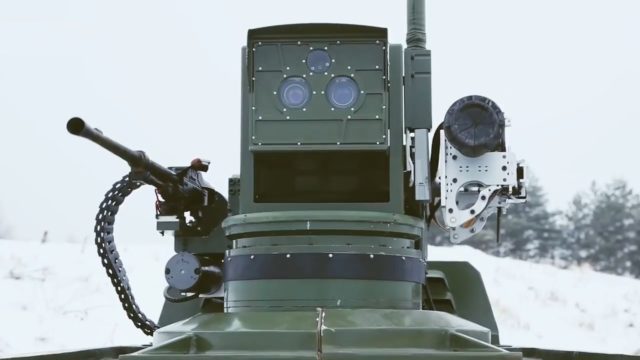
Moscow Pursues Artificial Intelligence for Military Application
Publication: Eurasia Daily Monitor Volume: 16 Issue: 89
By:

Moscow is actively pursuing research and development (R&D) on artificial intelligence (AI) for military purposes, partly driven by the views of its leading military theorists on the nature of future warfare and also by fears that other international actors, including the United States, are making advances in this field (see EDM, June 5). It has been widely reported that various prototype robotic systems underwent experiments during Russia’s military operations in Syria. However, information on the specifics of these systems has proven elusive. Nonetheless, some of the advances made by Russia’s defense industry in the field of military robotics will be displayed during the forthcoming Army 2019 exhibition in Moscow, on June 25–30 (Bfm.ru, May 28).
It appears that the interest in exploiting AI for military purposes covers a number of areas, ranging from simulators to systems that aid in targeting. Reportedly, the Army 2019 exhibition will also showcase examples of ground-based robotic complexes. The main beneficiaries of such technologies will be the Airborne Forces (Vozdushno Desantnye Voyska—VDV) and the Ground Forces. The Khameleon interactive rifle complex uses AI to offer elements of virtual reality for its user. AI has also been the focus in designing a simulator for the VDV known as Kudesnik. Although few details are publicly available on these or other robotic systems, the Kudesnik simulator additionally has automated functions and will soon be used in combat training for VDV personnel. Army 2019 will display a ground-based robotic complex referred to as Mars (Bfm.ru, May 28). Mars is described as a robotic truck and has already been tested by the VDV at the Ryazan Airborne School. It functions in a combat support role to help evacuate wounded personnel as well as to deliver cargo (Regnum, May 28). Whereas, according to other sources, the Mars complex also functions as a rocket system (M24.ru, May 28).
Indeed, the VDV particularly benefits from the application of AI and robotic technology in terms of its growing role in the Arctic. The defense ministry boasts that the VDV will receive the latest advances in robotics in order to boost survivability in Arctic conditions as well as improve its combat training with state-of-the-art simulators. According to the head of the scientific and research department at the Ryazan Airborne School, Colonel Vasily Yelistratov, the VDV receives 30 to 40 patents annually and up to 160 rationalization proposals. “All patented results are aimed at modernizing existing and developing new types of weapons, military and special equipment for the troops,” noted Elistratov (M24.ru, May 28).
Although many of these systems will be displayed during the Army 2019 exhibition, few details are available about how these were developed or concerning their precise specifications. This is also the case regarding robotic technology designed for a combat role. Such systems are certainly in existence and undoubtedly also feature in ongoing R&D. In February, the Advanced Research Foundation (Fond Perspektivnykh Issledovaniy—FPI), in Moscow, released a video featuring tests of a promising robotic platform designated as “Marker.” The Marker experimental platform is a joint project of the FPI and the firm NPO Androidnaya Tekhnika. The compact Marker vehicle is armed with two anti-tank guided missiles and a Kalashnikov assault rifle. The overall aim in its design is to reduce the role of the operator and increase the autonomous capacity of the robotic platform. The Marker, therefore, can be controlled remotely or work in tandem with a service member, receiving targeting information from the sight of his weapon. The FPI is at the cutting edge of such research, and its main development areas are autonomous control, image recognition, group interaction, orientation and navigation, technical vision, payload management, and robotics for a combat role (Topwar.ru, February 19).
These developments, as noted, fit into the work of leading Russian military theorists and their thinking concerning future warfare. For these theorists, future warfare has many different aspects; but they consistently refer to the increasing role played by AI and robotics (Voyennaya Mysl, No. 4, 2013). It appears that the defense leadership takes seriously the potential role of such platforms, and the Army 2019 event will draw further attention to this element of future military modernization (Regnum, May 28, 2019). Russia’s minister of defense, Army General Sergei Shoigu, recently noted the extent to which advances in science and technology are changing the means and methods of modern combat in the country’s Armed Forces. In highlighting the introduction of new and advanced systems, Shoigu also stated, “In the near future, the army and navy will receive a completely new, unparalleled weapon based on hyper-sound technology and laser energy” (Krasnaya Zvezda, June 19). These advances in modernizing the military appear to include a determined and long-term plan to exploit AI and robotic platforms for military use (Mil.ru, accessed June 19).
Advances in Russia’s experiments with robotic technology and AI for military use stem from a determined state-level planning process to boost R&D and investment in designing and building such complexes for the military. Undoubtedly, some of this draws on experience and experimentation in Syria. But the complex processes of R&D in military robotics is inclusive of a number of military research centers such as the FPI (M24.ru, May 28). It is unclear to what level the defense ministry is investing in military robotics, but there is clear evidence that it is seeking to exploit such advances while also continuing to monitor similar efforts in foreign militaries.



